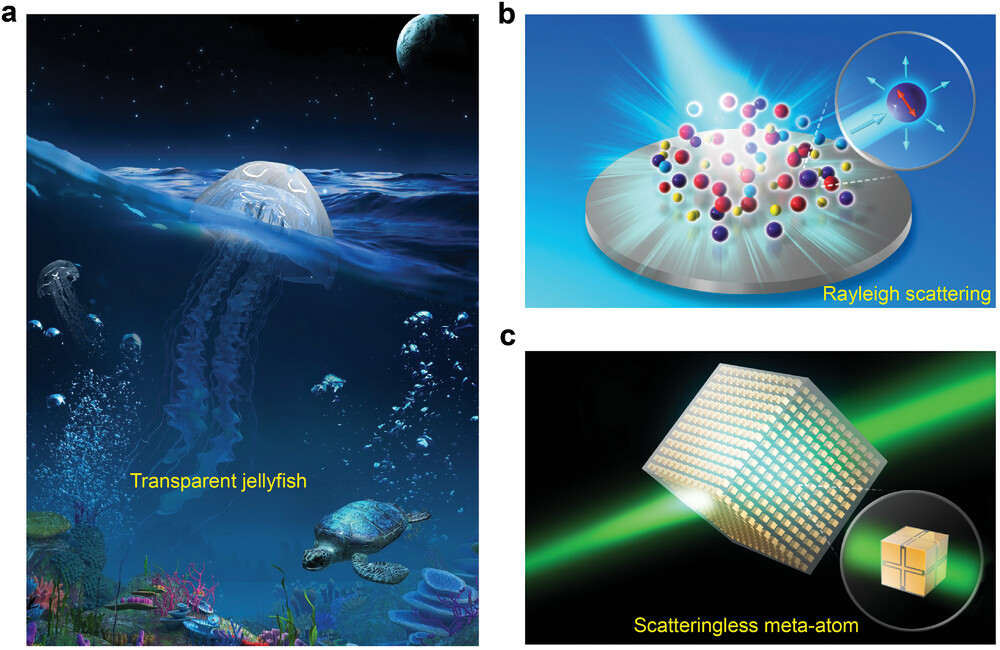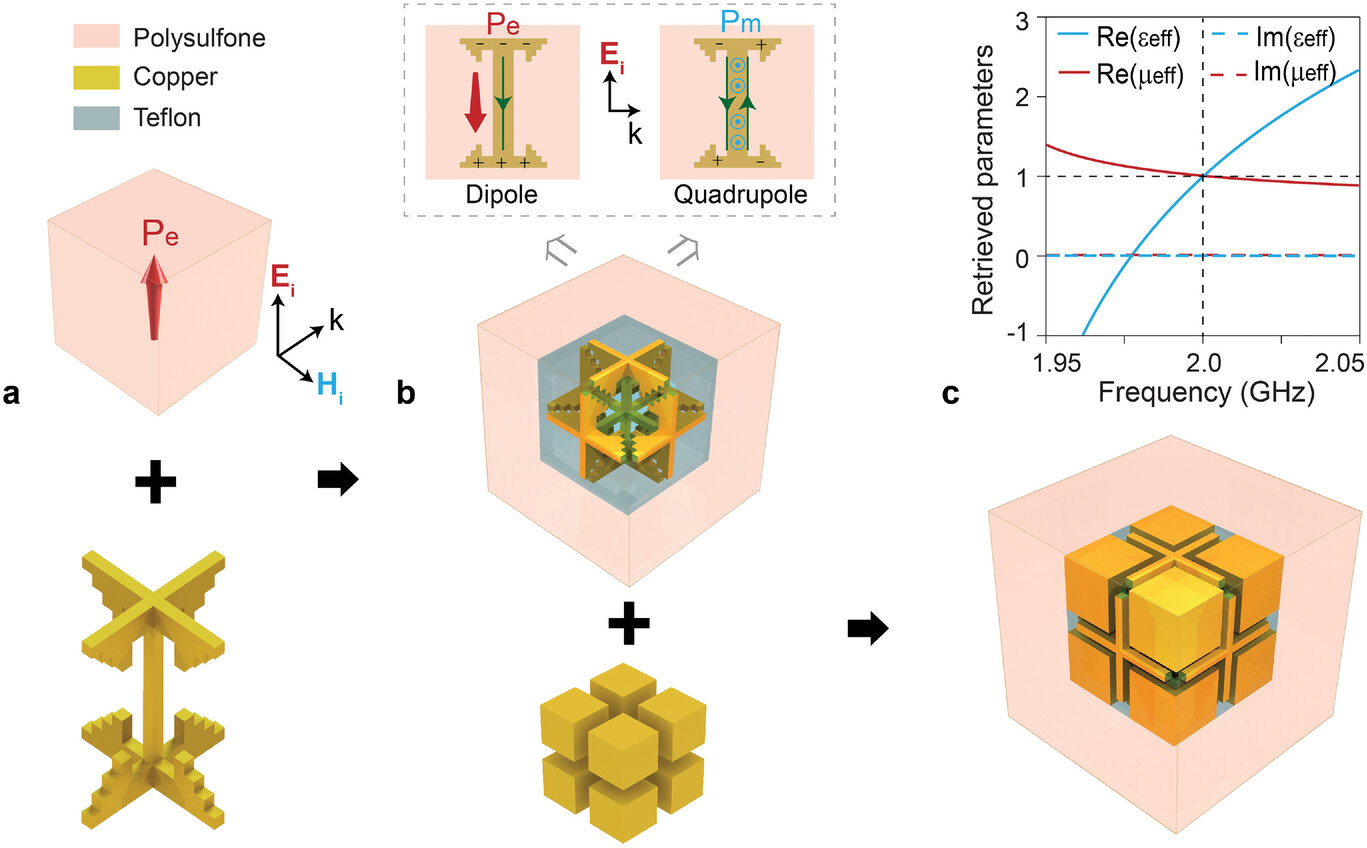| Dec 16, 2023 | |
Overcoming a fundamental challenge to enable scattering-free optical transparency |
|
| (Nanowerk Spotlight) Ever since the first observations of light scattering by particles in the 19th century, achieving ideal optical transparency has posed an enduring grand challenge. Natural solid things like rocks or crystals tend to make light zigzag or spread out in different directions. This happens because these materials interact with light differently than the air around them does, due to their unique property called electric permittivity. Electric permittivity is basically how well a material can 'conduct' electric fields, which includes light. | |
| Now, researchers have reported a breakthrough meta-atom design that exhibits nearly ideal optical transparency by fully neutralizing its internal polarization and magnetization. The findings were published in Advanced Materials ("Nearly Ideal Transparency with Artificially Designed Meta-Atoms"). | |
 |
|
| Concept of ideal transparency. a) Transparency and visibility happened simultaneously on a jellyfish at its body parts in seawater and air. b) Rayleigh scattering under external illumination. c) Scatteringless behavior by artificial meta-atoms. (Reprinted with permission by Wiley-VCH Verlag) | |
| Past attempts at eliminating scattering from objects have seen limited success. Applying plasmonic coatings can suppress just a few Mie scattering coefficients of spherical particles. Anapole states via careful interference of electric and magnetic modes can reduce scattering from some simplified shapes. However, these approaches fail for general geometries and electrically large constructs. A fundamental roadblock is that natural materials intrinsically respond to external polarizations in ways that stimulate secondary radiation and scatter light. | |
| The key innovation here lies in engineering artificial meta-atoms at the subwavelength-scale to behave effectively like vacuum across all illumination angles. The design combines an isotropic three-dimensional arrangement of metallic I-shaped resonators inserted into a dielectric cube with additional blocks to neutralize magnetization. Together these tailored internal elements induce responses that counter the cube’s natural polarization and make it scatter-free. | |
| Full wave simulations and experimental measurements confirm the meta-atom and any arbitrary aggregation of them remain transparent while retaining refractive properties like bending light. Constructing objects by tiling these meta-atoms produces macroscopic vacuum-imitating metamaterials. For example, the researchers demonstrated near-ideal transparency from a 4x4x4 cube and a sheet resembling an aircraft wing despite altering orientation and polarization. | |
| Such perfectly invisible structures unlock novel potential applications like radar-evading aircraft, disturbing-free walls for communications, and optical filters or lenses. The proposed meta-atom serves as an enabling building block to manipulate diffraction and wavefronts without reflections or shadows. Its reliable scattering suppression substantially advances previous attempts limited to fixed shapes or incident angles. | |
 |
|
| The structural configuration of the meta-atom. a) The dielectric cube and the I-shaped metallic structure. b) The composition of the dielectric cube, the I-structure, and the anti-magnetic metallic blocks. c) Final assembly of the meta-atom. The effective permittivity and permeability of the metamaterial are shown in the upper panel. It is obvious that εeff = ε0 and εeff = µ0 are satisfied at ∼2.0 GHz. (Reprinted with permission by Wiley-VCH Verlag) | |
| The realization relies on innovation in both conceptual strategy and implementation. Designing the meta-atom requires comprehensive neutralization of polarization responses through all three dimensions. The specific geometry of resonators and anti-magnetic blocks achieves this by inducing oppositely oriented electric and magnetic dipoles that mutually cancel out under arbitrary external excitation. | |
| Physically fabricating these subwavelength elements poses immense precision demands. The construction here combines stainless steel, silver plating, teflon, and polysulfone plastic to approximate the intended structure within manufacturing limitations. The resulting metamaterial exhibits slightly degraded but still exceptional transparency compared to simulations. Ongoing improvements in nanofabrication will further unlock metamaterials’ full potential. | |
| Nonetheless, the experimental results successfully validate the novel meta-atom’s game-changing capacity for transparency in free space. Despite imperfections, stacks of fabricated meta-atoms clearly outperform conventional dielectric substances like teflon in minimizing scattering signatures. This confirms simulations showing any configuration of meta-atoms essentially behaves electromagnetically identical to vacuum. | |
| The demonstrated concept extends across the electromagnetic spectrum, offering a universal strategy for optical transparency. Dielectric resonators with similar responses to the studied metallic inclusions could translate these findings towards visible light and communication frequencies. If realizable at the nanoscale, such metamaterials may eventually produce broadband invisibility cloaks. The current realization still requires an operation frequency aligning electric and magnetic resonances. | |
| This breakthrough demonstration of customizable transparency via meticulously engineered meta-atoms represents a major milestone for dynamically controlling light propagation. The techniques open possibilities for novel optical devices like perfect lenses, distortion-free imaging systems, and scattering-suppressing barriers with huge potential in aerospace, biomedicine, AI, and communications. | |
| On a more profound scientific level, the ability to fundamentally counteract natural material responses could radically transform how we conceptualize crafting manufactured structures with customized interactions beyond normal limits. As nanofabrication precision improves, dynamically designed metamaterials may unleash capabilities like broadband invisibility cloaks that fully divert the flow of light at will. By transcending an enduring grand challenge in optics, this research signals a new era in relentlessly sculpting electromagnetic waves to human imagination’s desire. | |
 By
Michael
Berger
– Michael is author of three books by the Royal Society of Chemistry:
Nano-Society: Pushing the Boundaries of Technology,
Nanotechnology: The Future is Tiny, and
Nanoengineering: The Skills and Tools Making Technology Invisible
Copyright ©
Nanowerk LLC
By
Michael
Berger
– Michael is author of three books by the Royal Society of Chemistry:
Nano-Society: Pushing the Boundaries of Technology,
Nanotechnology: The Future is Tiny, and
Nanoengineering: The Skills and Tools Making Technology Invisible
Copyright ©
Nanowerk LLC
|
|
|
Become a Spotlight guest author! Join our large and growing group of guest contributors. Have you just published a scientific paper or have other exciting developments to share with the nanotechnology community? Here is how to publish on nanowerk.com. |
|
